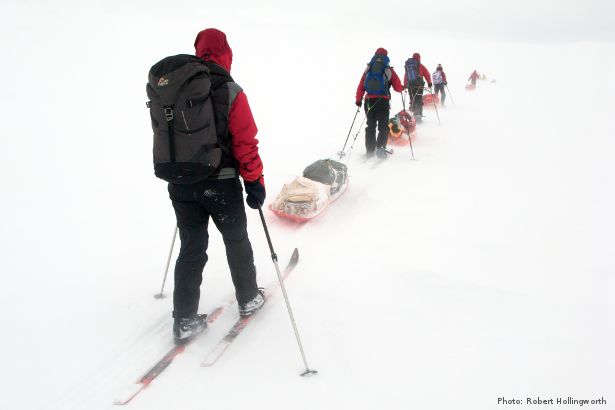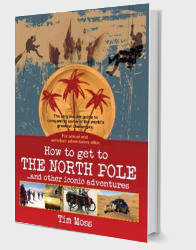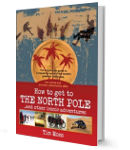
Expeditions to the North and South Poles have a lot in common and it can be easy to assume that they are both pretty much the same – cold and white. However, they are very different in a number of ways. Below are some of them.
[divide]
[box type=”note” bg=”#ebebeb” color=”#111″ font=”arial” fontsize=”13″ border=”#a6a6a6″ head=”How To Get To The South Pole” headbg=”#21417b” headcolor=”#fff”]
This is an edited excerpt from the How To Get To The South Pole chapter of my new book: How To Get To The North Pole And Other Iconic Adventures.
[button color=”green” link=”http://thenextchallenge.org/books” size=”big” font=”arial” fontw=”bold” textcolor=”#fff” texthcolor=”#d00000″ align=”center” radius=”8″]Order Now[/button]
[/box]
[divide]
The Arctic
The Arctic is an ocean surrounded by continents.
It is defined by the Arctic Circle at 66.5º north which marks the edge of 24 hour days and nights.
North Pole expeditions are largely conducted on the frozen sea ice surface of the Arctic Ocean. Water is always flowing beneath your feet and in many areas there is a constant threat of falling through the ice.
Polar bears live only in the Arctic. Seals of varying types live in both the Arctic and Antarctica.
There are trees, roads, villages and shops inside the Arctic Circle but nothing permanent exists on the Arctic Ocean as it constantly moves and melts.
The North Pole is only ever a metre or two above sea level depending on the thickness of the ice.
There is nothing at the location of the North Pole.
The Arctic Ocean is very humid. Managing moisture inside a tent is critical during North Pole expeditions.
On average, the Arctic is not as cold as Antarctica. However, most North Pole expeditions cannot operate at the Arctic’s warmest because the sea ice melts so, in practice, it can be just as cold.
Antarctica
Antarctica is a continent surrounded by oceans.
There is an Antarctic Circle at 66.5º south but Antarctica refers to the continent.
South Pole expeditions operate on ice but largely with land beneath it.
Penguins live in Antarctica. They live outside the Antarctic Circle too but never in the Arctic. The aggressive Leopard seals live in Antarctica but not the Arctic.
A few permanent and seasonal bases exist in Antarctica, mostly research stations, including one at the South Pole. There are no roads, villages or trees though.
The South Pole is at an elevation of almost 3,000 metres.
The South Pole is marked by a nearby research station, circle of flags and a stripey pole for posed photographs.
Antarctica is the driest of the seven continents and technically a desert. Any ‘snowing’ that you experience is almost certainly the result of snow on the ground being blown by wind.
Antarctica is colder than the Arctic but most people will plan their expeditions for the warmer summer and the dryness also makes it easier to handle the cold.
[divide]
How to Get to the North Pole:
and Other Iconic Adventures
Newly published for April 2012
[button color=”green” link=”http://www.thenextchallenge.org/books/” size=”big” target=”_blank” font=”arial” fontw=”bold” textcolor=”#fff” align=”center” radius=”10″]Order Now[/button]


What do you think? Please do add your thoughts below…